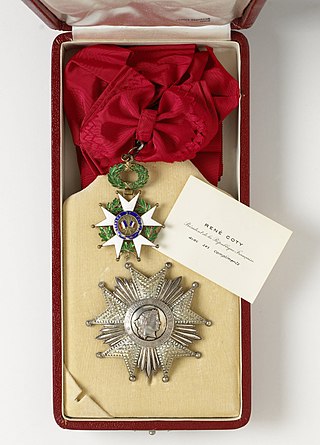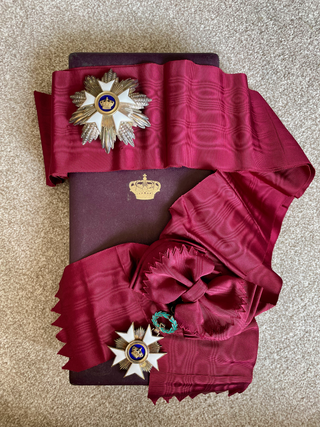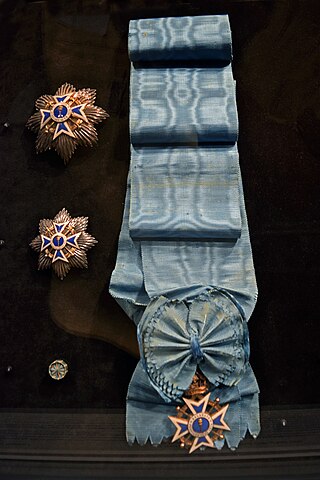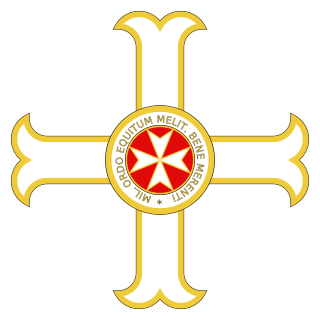
The National Order of the Legion of Honour, formerly the Imperial Order of the Legion of Honour, is the highest French order of merit, both military and civil, and currently comprises five classes. Established in 1802 by Napoleon Bonaparte, it has been retained by all later French governments and regimes.

The Most Excellent Order of the British Empire is a British order of chivalry, rewarding contributions to the arts and sciences, work with charitable and welfare organisations, and public service outside the civil service. It comprises five classes of awards across both civil and military divisions, the most senior two of which make the recipient either a knight if male or a dame if female. There is also the related British Empire Medal, whose recipients are affiliated with, but not members of, the order.

The Royal Order of Kamehameha I is an order of knighthood established by Kamehameha V in 1864, to promote and defend the sovereignty of the Hawaiian Kingdom. Established by the 1864 Constitution, the Order of Kamehameha I is the second order of its kind in Hawaii.

The Order of Leopold is one of the three current Belgian national honorary orders of knighthood. It is the oldest and highest order of Belgium and is named in honour of its founder, King Leopold I. It consists of a military, a maritime and a civil division. The maritime division is only awarded to personnel of the merchant navy, and the military division to military personnel. The decoration was established on 11 July 1832 and is awarded by Royal decree.

The Order of the Crown is a national order of the Kingdom of Belgium. The Order is one of Belgium's highest honors.

The Order of Orange-Nassau is a civil and military Dutch order of chivalry founded on 4 April 1892 by the queen regent, Emma of the Netherlands.

The Royal Order of the Sword is a Swedish order of chivalry and military decoration created by King Frederick I of Sweden on 23 February 1748, together with the Order of the Seraphim and the Order of the Polar Star. The motto of the order is in Latin: Pro Patria.

The Royal Norwegian Order of Saint Olav is a Norwegian order of chivalry instituted by King Oscar I on 21 August 1847. It is named after King Olav II, known to posterity as St. Olav.

The Order of Civil and Military Merit of Adolph of Nassau is an order of merit of the Grand Duchy of Luxembourg for meritorious service to the Grand Duke, the Grand-Ducal House and Luxembourg. It was founded in 1858 as a chivalric order of the Duchy of Nassau by Adolphe of Nassau in honor of his namesake and ancestor, Adolf, Count of Nassau, the only member of the House of Nassau to have been Roman King of Germany. After the Duchy of Nassau was annexed by Prussia in 1866 and Adolphe became Grand Duke of Luxembourg in 1890, he revived the order as an order of merit.

The Royal and Military Order of Saint Louis is a dynastic order of chivalry founded 5 April 1693 by King Louis XIV, named after Saint Louis. It was intended as a reward for exceptional officers, notable as the first decoration that could be granted to non-nobles. By the authorities of the French Republic, it is considered a predecessor of the Legion of Honour, with which it shares the red ribbon.
The Order of Leopold II is an order of Belgium and is named in honor of King Leopold II. The decoration was established on 24 August 1900 by Leopold II as Sovereign of the Congo Free State and was in 1908, upon Congo being handed over to Belgium, incorporated into the Belgian awards system. The order is awarded for meritorious service to the sovereign of Belgium, and as a token of his personal goodwill. It can be awarded to both Belgians and foreigners, and is seen as diplomatic gift of merit.

The Royal Order of the Polar Star, sometimes translated as the Royal Order of the North Star, is a Swedish order of chivalry created by King Frederick I on 23 February 1748, together with the Order of the Sword and the Order of the Seraphim. The Order of the Polar Star is intended as a reward for Swedish and foreign "civic merits, for devotion to duty, for science, literary, learned and useful works and for new and beneficial institutions".

The Royal Order of Kalākaua I was instituted on 28 September 1874 by King Kalākaua I to commemorate his accession to the throne of the Kingdom of Hawaiʻi on 12 February 1874.

The Order of the Star of Romania is Romania's highest civil Order and second highest State decoration after the Order of Michael the Brave. It is the oldest Order of Romania. It is awarded by the President of Romania, and has six grades, from lowest to the highest: Knight, Officer, Commander, Grand Officer, Grand Cross, and Grand Cross with Collar.

The National Decorations System of Romania is divided into six categories, listed below. It was re-established in 1998 after a 50-year period in which Romania used a Soviet-style system of decorations. It is very similar to the system used in Romania during the interwar period.

The Military Merit Medal was a military decoration of the Empire of Austria-Hungary. It was founded by Emperor Franz Joseph I on March 12, 1890. The Military Merit Medal is often referred to as the "Signum Laudis" after the inscription on the reverse of the medal.

The Order of Merit is the order of merit of the Sovereign Military Order of Malta, established in 1920. It is awarded to recipients who have brought honour to the Sovereign Military Order of Malta, promoted Christian values and for charity as defined by the Roman Catholic Church. Unlike Knights or Dames of the Order of Malta, those decorated with the Order are not invested in a religious ceremony, do not swear any oath or make any religious commitment. It may therefore be bestowed upon non-Catholics. Conferees include prominent statesmen, such as Presidents Ronald Reagan, who received it while still in office, and George H. W. Bush.

The Royal Order of Cambodia was a colonial order of chivalry of French Cambodia, and is still in use as an order of chivalry in the present-day Kingdom of Cambodia.

The National Order of Faithful Service is the second highest national order of Romania after the Order of the Star of Romania, and the third highest State decoration, with the Order of Michael the Brave being the first. Originally it was established as the Medal of Faithful Service in 1878, during the reign of King Carol I. In 1906, the Cross of Faithful Service was added to the existing medal, as a superior class. During the reign of King Carol II, in 1932, the Order was established with four ranks: grand cross, grand officer, commodore, and officer.

The Order of Aeronautical Virtue is a Romanian military decoration created by King Carol II on 31 July 1930. Originally, the Order had three ranks: Knight, Officer and Commander, as well as a "Golden Cross" rank as the lowest one. The first two ranks could be awarded three times consecutively, with a metal bar attached to the ribbon for each new decoration. Today, the order maintains the "classic" ranks of Knight, Officer and Commander, and Grand Officer, and can no longer be awarded consecutively.



























